� ��
Island of Rab - Main Information |
|
| |
The island of Rab is situated in the Kvarner group of islands between 44º51' NN and 14º53'. It spreads in the NN-SI direction, 22 km long from cape Sorinj in NW to cape Glavina in SE. It biggest width is 11 m.
The Velebit canal separates the island from the mainland. The closest gets to the mainland is on its SE end, 2 km. It is separated from the island of pag by the «Pasko tijesno» canal, in the west, towards Cres and Losinj, there is Kvarneric, and «Senjska Vrata» separates it from the island of Krk in the NW.
There are lots of smaller islands around Rab: Goli, Grgur, Maman, Lagnj Veli, Laganj Mali, Dolfin Veli, Dolfin Mali, Trstenik, Dolin, Sv. Juraj. Other than the small town of Rab, there are 7 idyllic places on the island situated on different parts of the island: Barbat, Banjol, Palit, Kampor, Mundanije, Supetarska Draga and Lopar. The island of Rab has approximately 10000 inhabitants who are mostly occupied in agriculture, fishing and tourism. The tradition of organised tourism on the island is more than 100 years old and it started through the activities of the «Society for promotion of the island and its Surroundings». Which has founded in 1889.
The reasons for the development of the tourism on the island, which are still current, are: attractive climate, the conditions on the island that have satisfying influence on the respiratory and cardiac problems. Such a long tradition of offering service of high quality is not just the result of skills, experience and hospitality of the people that is passed from one on to another, but also the result of the foundation of the catering and tourism school that s highly appreciated now days and of which we are proud.
The traditional hospitality and polyglot skills of the inhabitants will make you become a part of their family and after some time you will feel like a «born» islander!
Our tradition of organized tourism is more than 110 years old due to the formation of the "Society for improvement of the city and its surroundings" which was founded in 1889.The arguments for the development of tourism on the island were then and they are still today the following ones: pleasant climate, healing influence of the island air on the illnesses of respiratory system and heart diseases. Such along tradition of high quality services, which are offered to You, is not only result of skills, experience and hospitality of Your hosts, which inherited this knowledge from their ancestors and further enriched it, but also of formation of the "Tourist School" which is nowadays highly valued and we are all very proud of it.
|
 |
|
|
|
CLIMATE AND RELIEF |
|
| |
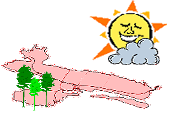 ISLAND OF RAB - CLIMATE ISLAND OF RAB - CLIMATE
The island of Rab has a very pleasant Mediterranean Sea climate, with mild winters and pleasant moderate summers. For such climate Rab has to thank to Kamenjak, a mountain chain that protects it from the cold northern wind in winter and early spring. In autumn there is a hot and humid wind from the south normally followed by rain. During the summer the heath is tempered by pleasant breeze.
Rab has approximately 91 completely sunny days a year and it is one of the sunniest parts of Europe. During the summer there are only 9 cloudy days. The number f sunny hours are around 2479 a year or 6 hour a day. In July the average is 12 sunny hours a day. The amount of rain is around 1042 mm a year.
The sea temperature is relatively high. That helps the development of tourist because it is possible to enjoy it from May till the middle of October. The approximate sea temperature a year is 15,75 ºC.
• The approximate sea temperature from May till October is over 20ºC, during the winter 12 ºC
• During the summer 26 ºC during the winter 8 ºC
|
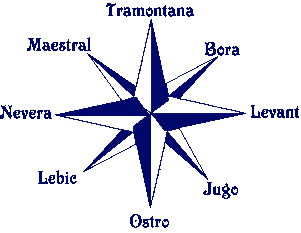 WINDS WINDS
Bura (north-eastern wind) and Jugo (southern wind) are the main winds in the Adriatic. They blow generally from September to May, while in the summer the main wind is landward breeze. Bura is a cold northeastern wind that blows from the inland towards the sea and brings good weather.
Jugo is humid southeastern wind, followed by the rain and heavy clouds and doesn't start suddenly (like Bura) but needs 36-38 hours to develop. The landwards breeze is a local wind that blows from the sea, mostly during the summer. Normaly it starts blowing around 10-11 a.m. and reaches the peak around 2 or 3 p.m. silecing down at sunset. It is followed by white clouds.
Other winds: burin, northeastern wind, it blows during the summer from the inland. Tramontana and eastern levant are more peaceful versions of bura.
|
|
RELIEF
What is characteristic and unusually beautiful in the relief of Rab is the rhythm of elevations, isthmuses and fields. The elevation that starts with peninsula Kalifront joins through the shallow and low Kampor field to bigger hills, spreading from northwest to southeast, from Gonar to Kaldana in Rab abd Banjol.
It is the rhythm of hills and flat stretches that makes the relief of Rab so characteristic and unusually beautiful. The rise that starts on the peninsula of Kalifront is continued, after crossing the valley of Kampor. By somewhat higher hills stretching NW to ES, from Gonar to Kaldanac (town of Rab) and to Banjol. Between these hills and the major range, Kamenjak, which runs parallel to the Velebit range on the mainland, there is a valley, which starts, north, in Supetarska Draga and ends at Banjol. The highest range of the island, Kamenjak (408m), whose slopes drop steeply down to the Velebit Channel, represents a natural barrier that protects the island from the cold northern wind - the bura.
The coast of the island is of varying indentedness, the northeastern part, at the foot of Kamenjak range, is hardly indented. Here, from cape Glavina to the peninsula of Lopar, the shore is uniform and steep. The peninsula Lopar abounds in shallow sandy beaches hidden in the many picturesque coves, which attract thousands of tourists in the summer months. The northwestern part of the island has two larger bays - Supetarska Draga and Kampor, and numerous smaller and larger coves. The western coast of the island is perhaps the most interesting. From the cape Kalifront to cape Frkanj there are many beautiful coves ideal for bathing and rest, the most outstanding being Sv. Mara, Kristofor, Cifnata, Gozinka and Matovica (off cape suha Punta). Further east lie the bays of Sv. Eufemija, the port of Rab, and the well-known Rab beaches - I, II and III Padova.
The island is surrounded by many islets and rocky reefs, which also enhance its irresistible charm. |
 |
| |
|
|
| ISLAND OF RAB - MAP with place description |
|
| |
|
 Other than the small town of Rab, there are 7 idyllic places on the island situated on different parts of the island: Barbat, Banjol, Palit, Kampor, Mundanije, Supetarska Draga and Lopar. Other than the small town of Rab, there are 7 idyllic places on the island situated on different parts of the island: Barbat, Banjol, Palit, Kampor, Mundanije, Supetarska Draga and Lopar.
RAB MAP
|
|
|
HISTORY - ISLAND OF RAB |
|
| |
|
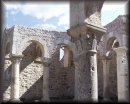 The earliest history of the Adriatic coast and islands is only the subject of legends, myths and stories. Somewhat more reliable date can be found in ancient Greek travelogues and seamen's guides. The earliest information on the Liburnian islands, Rab included, is provided by the geographical writings of Skylax of Chariandon (4th c. B. C.) Several Greek and Roman geographers also mention an island, which ought to be Rab, un their geographical writings. The mention Rab as Arba, Arbia, Arbiana or Arbitana, but the origins of the name are unknown. The present-day Slav inhabitants of the island, Croats, adapted the name to the spirit of their language by transforming it into Rab. The latter name probably dates from early as the 7th c. A.D., i.e., from the time immediately after the settlement of the first Slavs on the island. The museum of the Franciscan monastery of sv. Eufemija contains a Latin deed in the foundation of the monastery, from the mid-15th century; this is the (so far) oldest known document with the Croatian name of the island, Rab. The earliest history of the Adriatic coast and islands is only the subject of legends, myths and stories. Somewhat more reliable date can be found in ancient Greek travelogues and seamen's guides. The earliest information on the Liburnian islands, Rab included, is provided by the geographical writings of Skylax of Chariandon (4th c. B. C.) Several Greek and Roman geographers also mention an island, which ought to be Rab, un their geographical writings. The mention Rab as Arba, Arbia, Arbiana or Arbitana, but the origins of the name are unknown. The present-day Slav inhabitants of the island, Croats, adapted the name to the spirit of their language by transforming it into Rab. The latter name probably dates from early as the 7th c. A.D., i.e., from the time immediately after the settlement of the first Slavs on the island. The museum of the Franciscan monastery of sv. Eufemija contains a Latin deed in the foundation of the monastery, from the mid-15th century; this is the (so far) oldest known document with the Croatian name of the island, Rab.
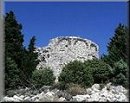
The stormy past and different historical periods have all left their traces here, in the numerous buildings of great value, which are carefully looked after. The alternation of rulers and powers also produced different architectural vestiges. The town of Rab, situated on a small peninsula, surrounded by the walls and with its four impressive belfries, resembles a ship with four masts that sails, sometimes easily and sometimes fighting the storm, but always forward.
HISTORY OVERVIEW:
|
|
|
|
|
| Legends, Myths and Stories |
|
| |
|
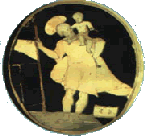 The stormy past and different historical periods have all left their traces here, in the numerous buildings of great value, which are carefully looked after. The alternation of rulers and powers also produced different architectural vestiges. The town of Rab, situated on a small peninsula, surrounded by the walls and with its four impressive belfries, resembles a ship with four masts that sails, sometimes easily and sometimes fighting the storm, but always forward. The stormy past and different historical periods have all left their traces here, in the numerous buildings of great value, which are carefully looked after. The alternation of rulers and powers also produced different architectural vestiges. The town of Rab, situated on a small peninsula, surrounded by the walls and with its four impressive belfries, resembles a ship with four masts that sails, sometimes easily and sometimes fighting the storm, but always forward.
Legend, People and Stories of Rab history:
1. St. Marin Legend
2. St. Christopher Legend
3. Markantun de Dominis
4.
Story: Draga, The Shepherdess of Rab
|
|
|
|

 |